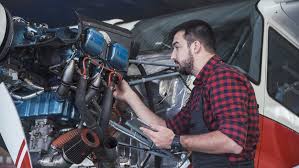How Aces Systems Are Changing Aviation Maintenance?

In the ever-changing field of aircraft maintenance, where accuracy and safety are of the utmost importance, introducing These systems represents a critical turning point. These cutting-edge technologies are revolutionizing traditional maintenance procedures, offering many benefits reverberating across the aviation industry thanks to their widespread application. The blog will examine the specifics of how These systems are transforming the landscape of aviation maintenance.
Predictive Maintenance Precision
The ability of these systems to anticipate potential problems before they become apparent is made possible by using sophisticated algorithms and real-time data processing. By continuously monitoring critical metrics like engine performance, component wear, and environmental conditions, these systems can estimate maintenance requirements with a precision that is unmatched by any other system.
This proactive strategy reduces downtime and improves operational efficiency, saving airlines important time and dollars.
Dynamic Condition-Based Monitoring
No longer are you bound by inflexible maintenance schedules based on defined intervals? These systems implement dynamic condition-based monitoring, bringing about a paradigm shift.
This monitoring method allows for the scheduling of maintenance jobs in response to the current health status of essential aircraft systems. These systems’ maintenance schedules are optimized by monitoring characteristics such as vibration, temperature changes, and fluid levels. This ensures that resources are given precisely where they are required and when needed.
Remote Diagnostics Revolution
Through the use of such systems, maintenance professionals are provided with the capacity to diagnose and solve problems remotely, hence overcoming geographical obstacles. Using sensors and cutting-edge networking solutions, technicians can remotely access onboard systems, identify defects, and even execute small repairs from a central location with aces systems.
This capacity not only lessens the need for expensive on-site visits but also speeds up the process of resolving maintenance issues, which ultimately minimizes the amount of time that aircraft cannot be flown and the disruption that occurs to flight schedules.
Elevating Safety Standards
Safety is considered the most important factor within the aviation business, and ace systems play a significant role in bringing safety standards to extraordinary heights. These technologies assist in identifying possible safety concerns before they pose a threat to flight operations by offering real-time monitoring and predictive analytics.
Furthermore, these systems greatly improve overall safety in the aviation ecosystem by optimizing maintenance operations and eliminating human error. This instills confidence in passengers as well as stakeholders, which is a win-win situation.
Harnessing The Power Of Data
The data generated by these systems is extremely extensive and pertains to aircraft performance, maintenance history, and operating factors. This abundance of data can be used by stakeholders to optimize maintenance methods, fleet management, and resource allocation, which acts as a powerful resource for informed decision-making.
The potential of data analytics can be used by airlines, allowing them to gain insights that may be used to drive continuous improvement, improve reliability, and save costs over the long run.
Integration of IoT and AI
These systems, which are at the vanguard of innovation, integrate with the Internet of Things (IoT) and Artificial Intelligence (AI) seamlessly, thereby ushering in a new era of intelligent maintenance solutions. These technologies make it possible to acquire and analyze data in real-time by establishing a cohesive network that connects the various sensors and systems that are installed onboard.
AI algorithms analyze this data, discovering patterns, abnormalities, and probable maintenance requirements with an unmatched level of precision. The Internet of Things (IoT) and artificial intelligence (AI) synergy is the peak of aviation maintenance technology. In this scenario, intelligent systems collaborate to ensure that aircraft perform at their highest potential and remain safe.
Conclusion
These systems are not only incremental advances; rather, they represent a paradigm shift in the manner in which aircraft maintenance is carried out. The adoption of predictive analytics, remote diagnostics, and data-driven insights by these systems enables airlines and maintenance providers to operate more efficiently, reduce the amount of time that they are offline, and improve safety standards. These systems testify to innovation, pushing development and influencing the future of aircraft maintenance. As the aviation industry evolves, systems continue to stand as a tribute to innovation.








